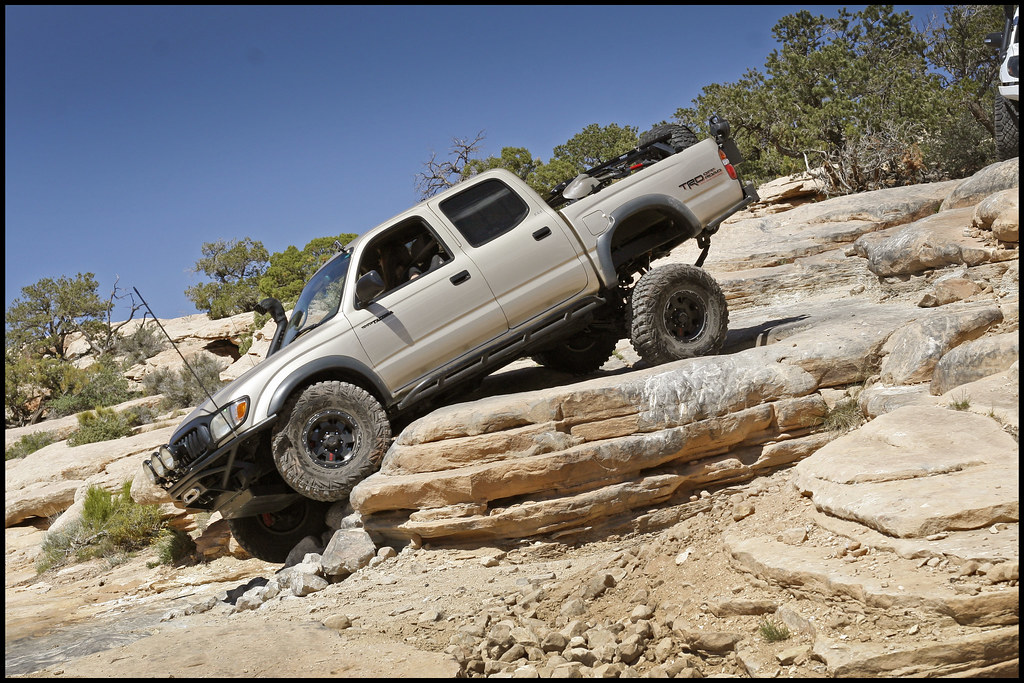I recently tackled the relocation of my rear shocks. This was for two reasons. One reason was that I wanted to do a ubolt flip to get a little better clearance under the axle, but the factory lower shock mount is on the ubolt plate so by removing that I needed new shock mounts. Secondly, with my rear suspension set up the OME nitrochargers were limiting my down travel earlier than I wanted so by moving the shock mounts I could get a bit more droop in the rear suspension which is helpful in the rocks since the IFS isn't really flexy at all. I need all I can get from the rear end.
I welded in a new crossmember and used some new shock brackets from Ruffstuff.
after some tweaking I think I ended up with pretty balanced travel from the 10" stroke OME shocks. Right about 5" of travel in droop and compression. I'm using the whole shock for sure and with the position of the shocks I'm getting a bit farther drop than I was in the stock location. It rides a little different (not bad just different). I welded in a new crossmember directly underneath the the upper mount on the driverside. This positioned the shocks behind the axle instead of one forward and one back. I supposed there is potential for some axle wrap with this setup compared to the stock configuration but others are using this approach with good luck. I chose to keep the shocks parralel vs angled to the center. The angled set up can give a bit more travel, but you lose some lateral stability. I wanted to keep the stability so I kept them parallel, but they are angled backwardward at a similar angle to the stock set up.
I used the ubolt flip kit from Trail Gear. As part of this mod I also wanted to relocate the rear axle. Under compression my tires were rubbing the front of the rear fenders. I got some relocation plates from Roger Brown that allows the axle to be moved 3/4" or 1" in either direction. I chose to move the axle backward 3/4". One note is that by moving the axle the spring center pin no longer lined up with the hole in the TG ubolt plate. I had to enlarge the hole in the plate to get it to fit over the spring center pin.





Driverside compression. The tire is now centered nicely in the wheelwell. Before the relocation plates the tires were chewing into the front of the fender even after some trimming.

Passenger side droop. there was more droop to be had but the tire was starting to climb the wall. You can see a fair amount of twist in the top leaf under full flex.


I've spoken to Kurt at Cruiser Outfitters about this (who I feel is as knowledgable about the OME products as anyone) and from all the information I've been able to get the OME Dakars are designed to be fairly flat at ride height. This allows for optimal ride over rutted/washboarded terrain that these springs were designed for. But for playing in the rocks and really flexing the suspension this means that a flat spring at ride height is going to go into negative arch quickly when compressed. After talking to Kurt it doesn't sound like anything I should be overly concerned about. I supposed there is potential for quicker spring fatigue if this is a common occurance, but after running the springs for 3+ years now with no ill effects I'm ok with it.
Here is the compressed spring with some pretty heavy negative arch. That's as far as it will go since it has arched to match the bottom overload leaf. I suspect that ARB knew the springs would flex this far since the overload leaf is the limiter and is in this position? You can also see that the rearward angle of the shock doesn't bottom it out and leaves a couple inches of travel left in the shock.

This let me check measurements for bumpstops. Looks like a 4" bumpstop will be just about perfect.
The flexed side. This is almost to the most droop the spring will allow and the shock is within .5" of full extension. So the shock might still be limiting full travel but only slightly. I think this is the best I can get with this setup.














